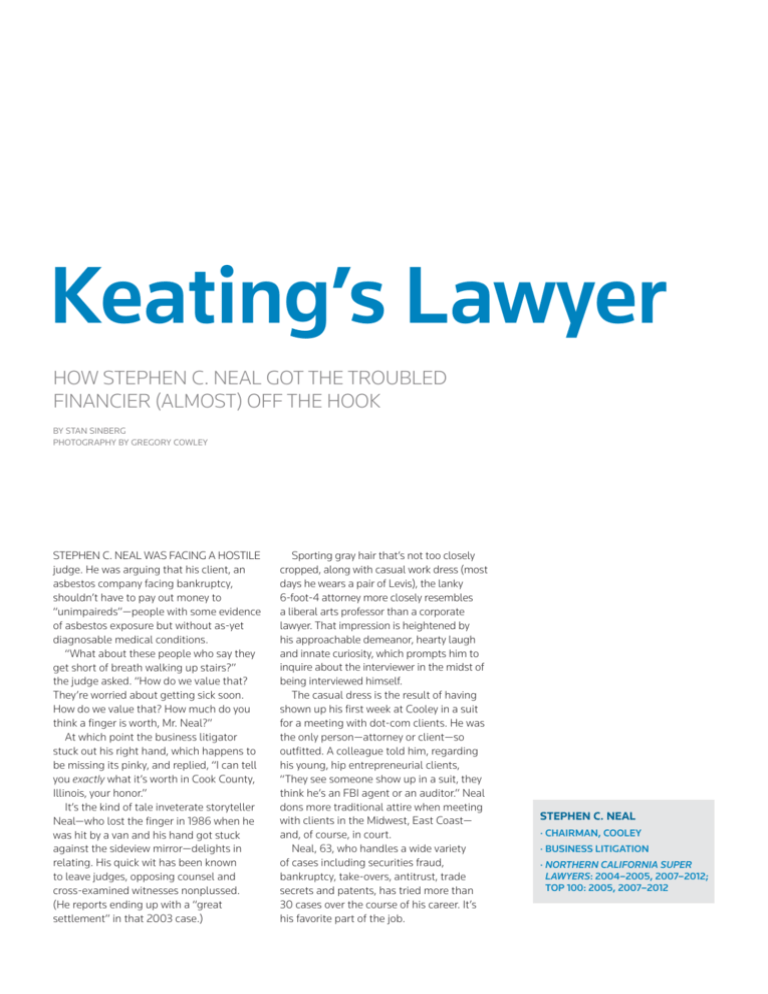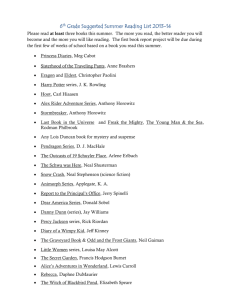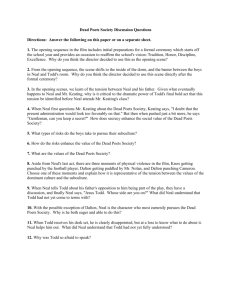
Keating’s Lawyer
How Stephen C. Neal got the troubled
financier (almost) off the hook
By Stan Sinberg
PHOTOGRAPHY BY Gregory Cowley
Stephen C. Neal was facing a hostile
judge. He was arguing that his client, an
asbestos company facing bankruptcy,
shouldn’t have to pay out money to
“unimpaireds”—people with some evidence
of asbestos exposure but without as-yet
diagnosable medical conditions.
“What about these people who say they
get short of breath walking up stairs?”
the judge asked. “How do we value that?
They’re worried about getting sick soon.
How do we value that? How much do you
think a finger is worth, Mr. Neal?”
At which point the business litigator
stuck out his right hand, which happens to
be missing its pinky, and replied, “I can tell
you exactly what it’s worth in Cook County,
Illinois, your honor.”
It’s the kind of tale inveterate storyteller
Neal—who lost the finger in 1986 when he
was hit by a van and his hand got stuck
against the sideview mirror—delights in
relating. His quick wit has been known
to leave judges, opposing counsel and
cross-examined witnesses nonplussed.
(He reports ending up with a “great
settlement” in that 2003 case.)
Sporting gray hair that’s not too closely
cropped, along with casual work dress (most
days he wears a pair of Levis), the lanky
6-foot-4 attorney more closely resembles
a liberal arts professor than a corporate
lawyer. That impression is heightened by
his approachable demeanor, hearty laugh
and innate curiosity, which prompts him to
inquire about the interviewer in the midst of
being interviewed himself.
The casual dress is the result of having
shown up his first week at Cooley in a suit
for a meeting with dot-com clients. He was
the only person—attorney or client—so
outfitted. A colleague told him, regarding
his young, hip entrepreneurial clients,
“They see someone show up in a suit, they
think he’s an FBI agent or an auditor.” Neal
dons more traditional attire when meeting
with clients in the Midwest, East Coast—
and, of course, in court.
Neal, 63, who handles a wide variety
of cases including securities fraud,
bankruptcy, take-overs, antitrust, trade
secrets and patents, has tried more than
30 cases over the course of his career. It’s
his favorite part of the job.
Stephen C. Neal
· Chairman, Cooley
· Business Litigation
· Northern California Super
Lawyers: 2004–2005, 2007–2012;
Top 100: 2005, 2007–2012
Back in 1989, he was retained by
Charles H. Keating Jr., whom he dubs “one
of the most vilified men of the last quartercentury.” Keating noticed that Neal was
getting his clients’ cases dismissed during
the Lincoln Savings civil litigation—one
of two lawyers to obtain that result out of
180 parties. Though Keating was fatalistic
about his trial prospects, he figured Neal
was an attorney who would build a good
case for an appeal.
Over the next several years, Keating
proved prescient: He lost his cases at trial,
but Neal got them all overturned on appeal,
including one that was ruled a violation of
due process based on instructions given
to the jury. After two years of negotiations,
Keating pleaded guilty to much more
limited bankruptcy charges, receiving no
fine and only time served.
Still, it is an earlier case that Neal touts
as his all-time favorite. Late one Friday
afternoon, he received a call from Inland
Steel management, whom he halfjokingly conjectures was “speed-dialing
for lawyers,” finding many gone for the
weekend or busy. Having worked at Inland
as a general laborer during college, Neal
thought, “I’ve made a lot of progress!”
After some 80 years, Inland Steel
was closing Sherwood Mine, located in
Michigan’s Upper Peninsula. The company
also ran the surrounding water-pumping
wells that kept the mines from flooding.
Inland Steel offered to sell the pumps to
the town for a dollar in lieu of shutting
them down. But the town, concerned
about operating costs and potential
liability, obtained a court order preventing
Inland from closing the pumps. Neal got
the case moved from state to federal
court, where a judge both granted Inland
the right to turn off the pumps, and Iron
River the right to sue Inland if flooding
resulted. The pumps were turned off
within 48 hours. Three months later,
floods engulfed Iron River.
At the trial, most of which was held in
the same Marquette, Mich., courthouse
where Anatomy of a Murder was filmed,
the plaintiffs' attorneys chided Inland
for bringing in “a Chicago lawyer.” The
plaintiffs then brought in David Todd
from UC Berkeley, considered the world’s
foremost water hydrologist. He appeared
on the witness stand with a globe and
pointed out 80 countries for whom he’d
consulted. On cross-examination Neal
asked Todd dryly, “Were you here when
they were giving me crap about coming
from Chicago?”
During the cross, Neal’s own local water
expert handed him a note. “Ask him to
describe for the jury the characteristics of
[Michigan’s] cedar swamps.” Todd drew a
blank, and Neal acted incredulous, serving
to undermine Todd’s local creds. Afterward,
a reporter came up to Neal. “There were
probably only two people in that courtroom
who didn’t have a clue about cedar
swamps,” the reporter said. “The witness
and the lawyer asking the question.”
Neal showed that the town had
periodically suffered floods over its history,
and argued that the recent flood just
coincided with the wells’ shutdown. The
jury ruled in favor of Inland Steel.
More recently, Neal got a call from
Kent Roberts, then-general counsel of
McAfee security-software company. It was
2006, and Roberts was in a tough spot.
The Department of Justice and the SEC
were issuing a flurry of investigations and
indictments of CEOs, CFOs and general
counsels, accusing McAfee and many other
companies of back-dating stock options.
Roberts was next in their sights, charged
by both agencies and summarily fired
from his job. Roberts hired Neal to fight
the charges, but the odds weren’t good:
The Justice Department’s record was 10
prosecutions; 10 guilty pleas or convictions.
Discovery started in late 2007, taking
place through the trial date, and about six
months afterwards. With the findings from
discovery, about a month before Roberts’
trial, the Justice Department dropped
four out of its seven criminal charges. On
the eve of the trial in 2008, Neal says he
finally got McAfee to turn over a number
of potentially exculpatory emails. When
U.S. District Judge Marilyn Patel saw
the correspondence—crucial to helping
exonerate Roberts—she declared, “Heads
will have to roll.” A jury subsequently
acquitted him, and shortly thereafter, the
SEC voluntarily dropped its case as well.
“Steve and his team got us the documents
that proved my innocence,” Roberts says. Of
13 people ever indicted on charges of backdating stock options, Roberts was the only
one acquitted by a jury.
In another recent case, Neal
represented Onyx Pharmaceuticals
against Bayer in a dispute that was
successfully settled eight days into
trial, granting Onyx co-rights to a drug
developed by Bayer under an ongoing
joint-development deal. Neal says
the drug has a number of potential
applications including treating colon,
kidney, liver and lung cancer.
Dr. N. Anthony Coles, Onyx’s president
and CEO, dubs Neal “a prince of a man.
From the start, Steve had great presence,
articulation and a dogged determinism
that we could win this case. He has a clarity
of thinking about the issues that others
can’t see, along with a great ability to
execute … a rare combination.”
Yet another major settlement came
in 2011, when Neal represented Nvidia
against chip-maker Intel, which claimed
it had the rights to some of Nvidia’s
graphics-processing information. Neal
relates telling Intel’s counsel, “I’m thrilled
you took action against us,” adding that
Nvidia hadn’t planned to sue Intel, but
since they “started it,” Nvidia would “finish
it.” Nvidia prevailed, and Intel had to fork
over $1.5 billion to continue licensing
Nvidia’s product.
Born in San Francisco, Neal grew
up on the peninsula and relocated at age
12 to Chicago’s South Side, an eclectic,
upscale and racially diverse neighborhood.
Elijah Muhammad, leader of the Nation
of Islam, lived two doors down; Joe Louis’
family lived across the street. The day
after Cassius Clay defeated Sonny Liston
(who lived around the corner) to become
heavyweight champion, Clay—who would
soon rename himself Muhammad Ali—
knocked on the Neals’ front door, offering
to buy the house. Neal and his three
brothers watched their parents’ reaction in
awe. “We were stunned that they wouldn’t
sell the house,” Neal says with a laugh.
Ali, who wanted to live near his spiritual
mentor, Elijah Muhammad, moved down
the block, and Neal periodically ran into Ali
at the local pizzeria. Elijah Muhammad’s
personal guards watched protectively over
everyone on the block, which was rounded
out by a house filled with basketballplaying Jesuit priests.
“For a 13-year-old moving from
the ‘WASP-y’ Stanford campus to an
integrated neighborhood with prizefighters—and [hearing the conversations]
the day Malcolm X was killed and Elijah
Muhammad was being blamed by some—
well, it was eye-popping,” Neal recalls.
The family’s moves were triggered by his
father’s career advancement. Phil Neal was
a law professor at Stanford, then migrated
to the University of Chicago Law School,
where he eventually became dean.
Neal says he wasn’t a particularly
good student in high school, so his father
devised a novel way to involve him in
academia: He made Neal read virtually
everything written on the cases of Sacco
and Vanzetti and Alger Hiss. The elder
Neal had worked for Hiss in the State
Department. These books instilled in
Stephen a deep sense of the importance
of due process.
While in college, Neal worked in a steel
mill and joined the union. “What I took away
from that experience is that I didn’t want to
be a steelworker,” he says with a laugh.
Upon graduating Stanford, he set his
sights on becoming a litigator. After Cooley
turned him down for a job, Neal returned to
Chicago, deeming it a great environment
for young lawyers, and specifically to
Kirkland & Ellis, where he’d spent the
summer before law school in a paralegaltype position.
After about two and a half years there,
a partner’s scheduling conflict led to Neal
trying his first big jury case. “A good number
of the jury were early middle-aged women
who probably thought I was their son,” he
says. “Juries are very forgiving of young
lawyers—they like to see them on their feet.
Most judges [also] understand that the very
lifeblood of our system is the continued
influx and development of new talent.”
One day while Neal was visiting
in California, co-chairing a fundraising
campaign at Stanford Law School with
Jim Gaither—then at Cooley—Neal took
him out for dinner. Gaither asked, “So
when are you coming home?” Neal replied,
“Damn, you’re good. I’m paying for my
own recruitment dinner.” A year later, Neal
jumped aboard.
After coming to Cooley in 1995,
Neal found that the high-profile cases
continued. He was named CEO and
chairman of the firm in 2001. Two
months later, the dot-com bubble burst,
necessitating the layoff of more than
100 attorneys and an equal amount of
staff. Neal was criticized in the media,
but he says there was just no work for
the attorneys. Some firms, he says, took
the same actions but disguised them
as “merit reviews” that both unfairly
stigmatized the young attorneys and
took longer, complicating their search for
other employment.
During Neal’s tenure as CEO, Cooley
opened offices in New York, Boston and
Washington, D.C. The firm also made a major
commitment to becoming a leader in pro
bono work, and now employs a partner full
time to administer pro bono activities. As for
Neal, mentoring the firm’s up-and-coming
attorneys is one of the best parts of the job.
“It’s enormously gratifying to watch those
younger lawyers keep emerging as superb,
skillful, front-line lawyers,” says Neal. “As a
profession, we get better every year.”
Reprinted from the August 2012 issue of Northern California Super Lawyers® magazine. © 2012 Super Lawyers®, a Thomson Reuters business. All rights reserved.






